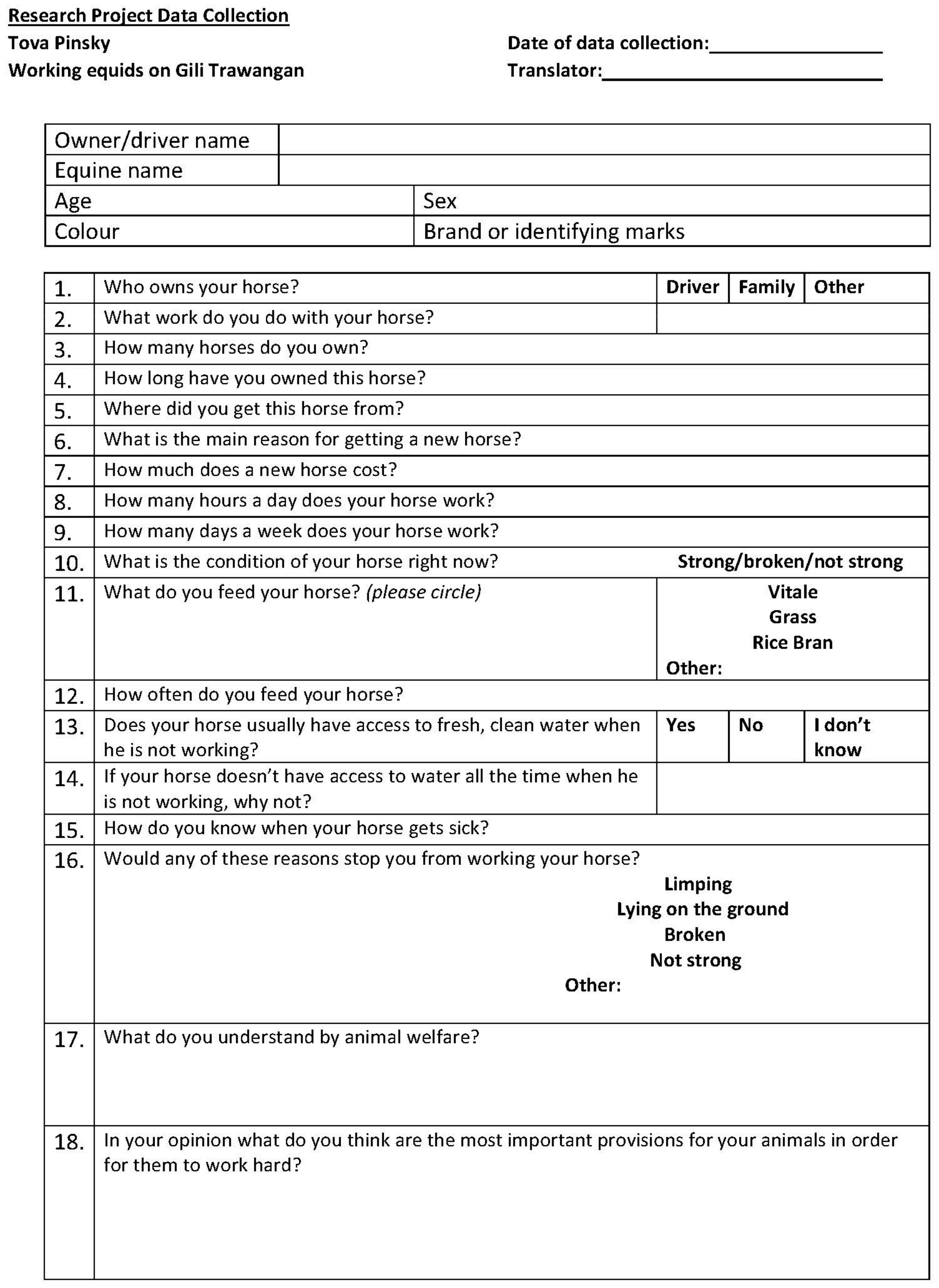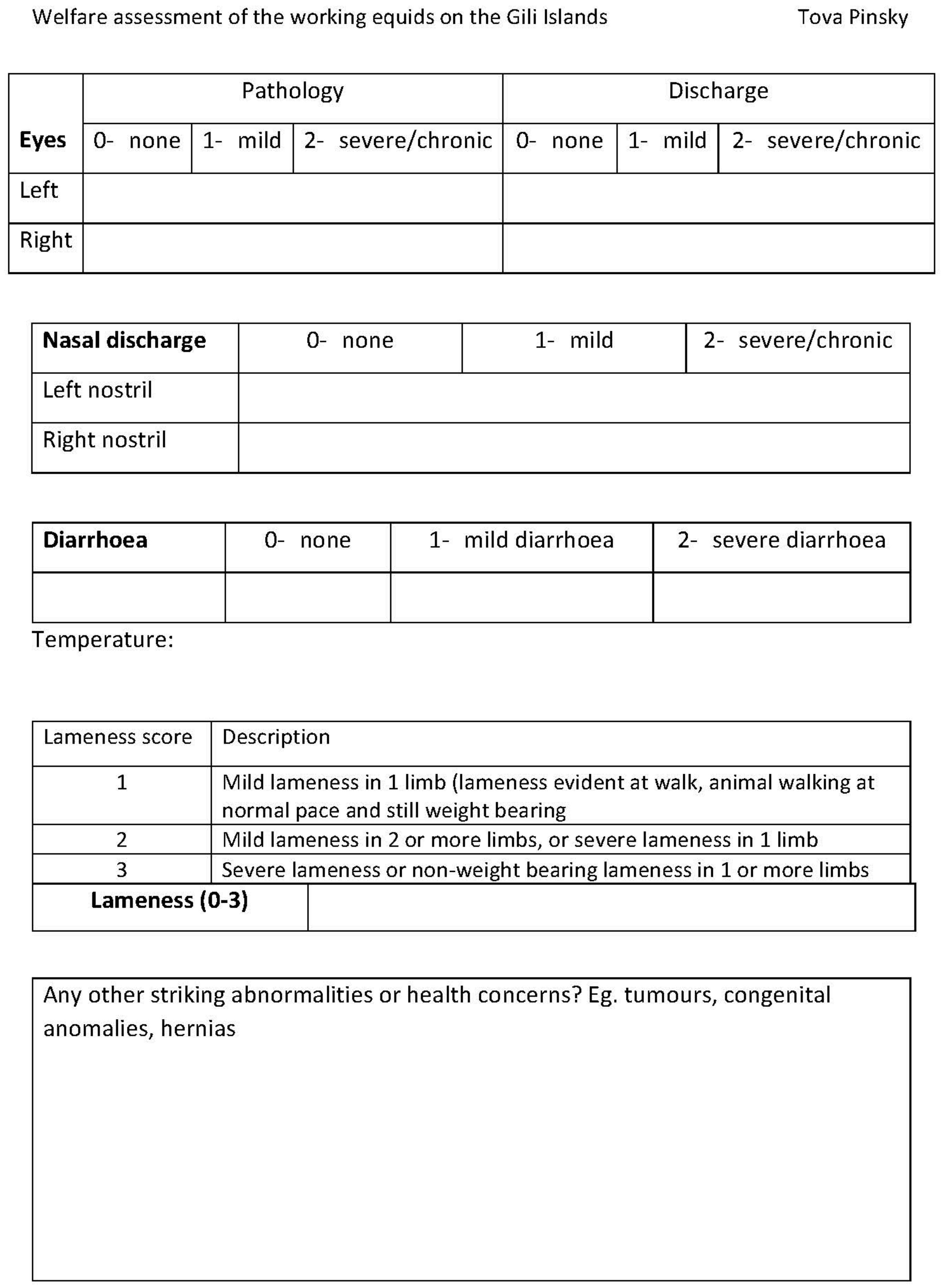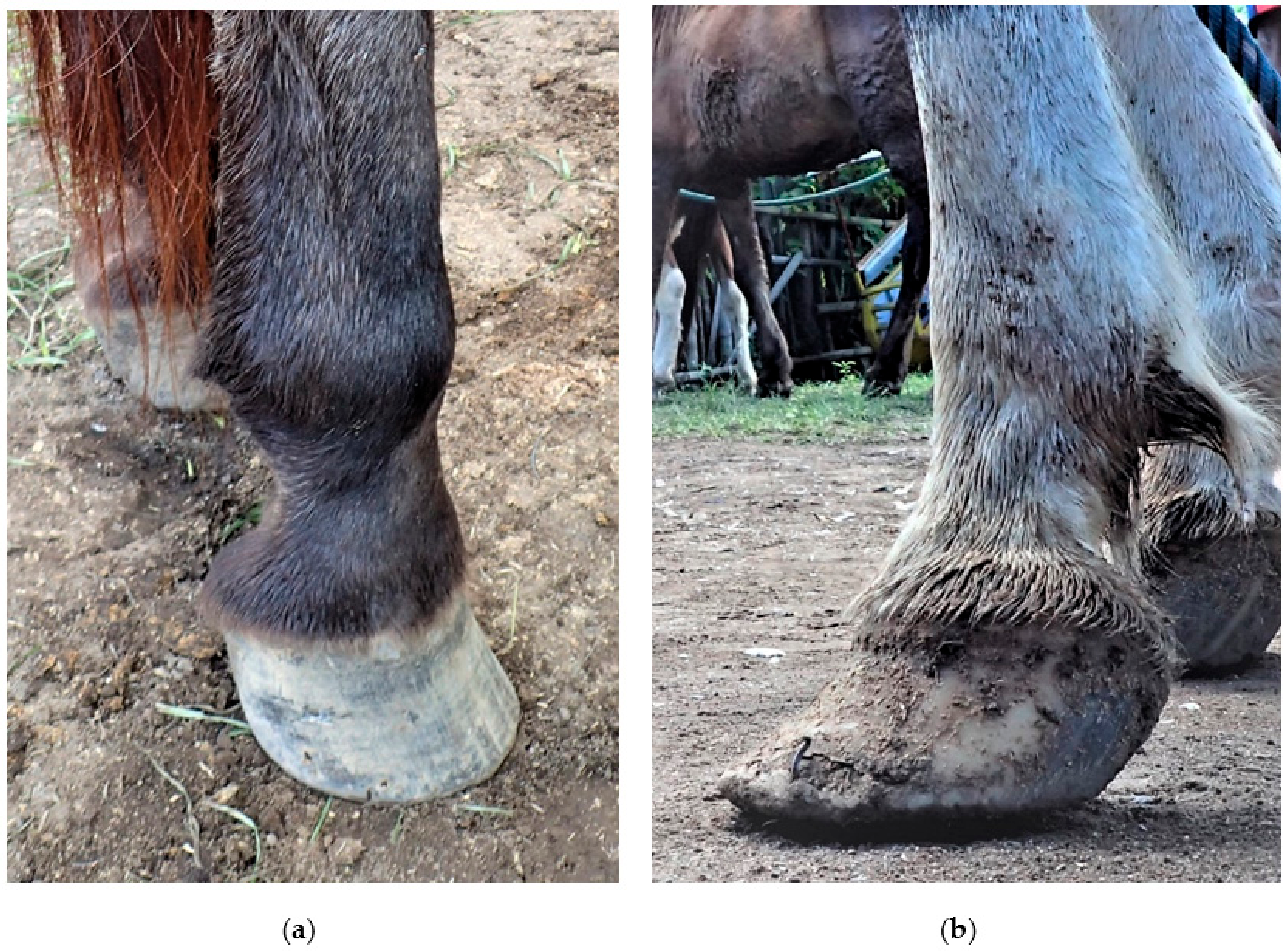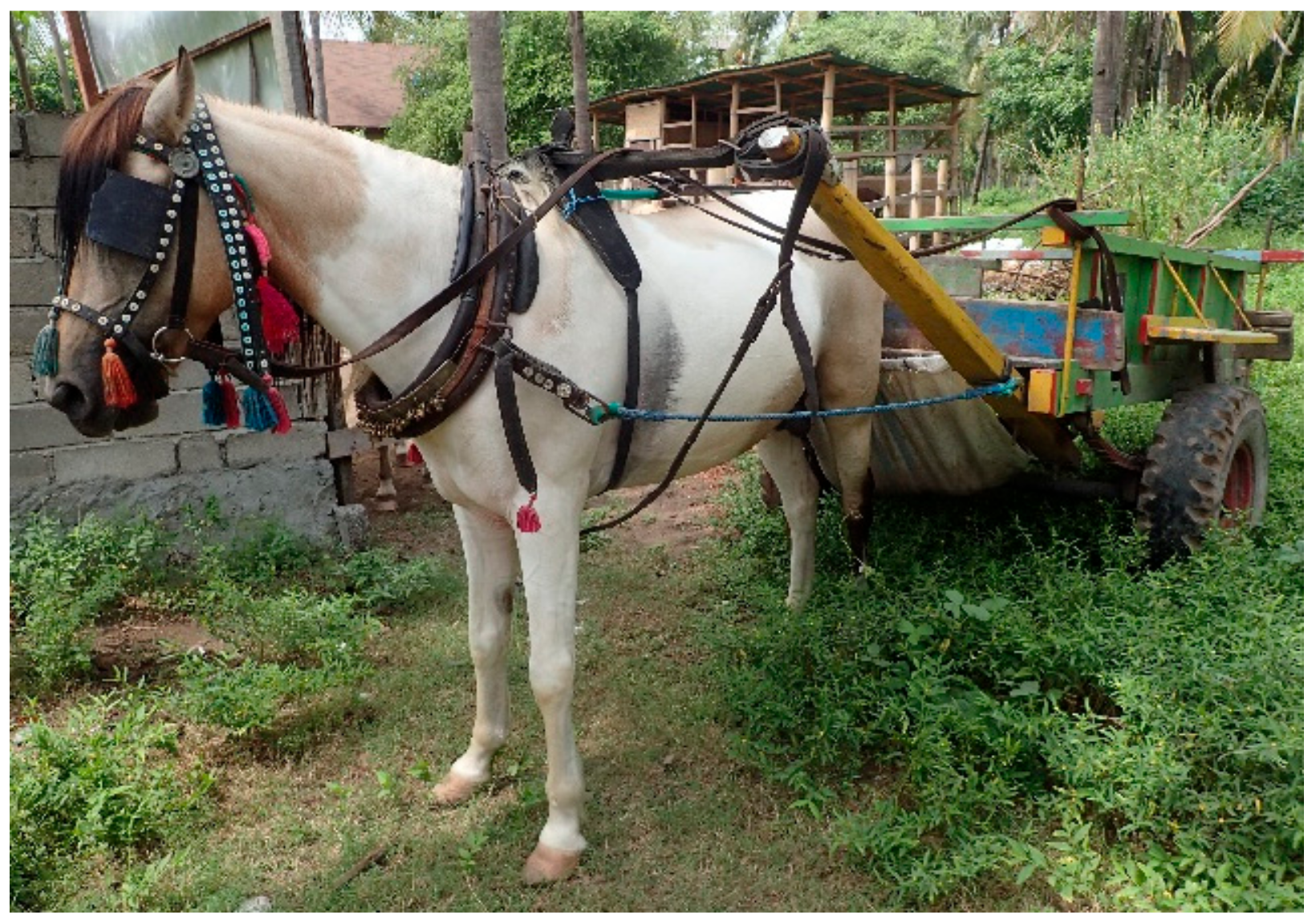A Pilot Welfare Assessment of Working Ponies on Gili Trawangan, Indonesia
Simple Summary
Abstract
1. Introduction
2. Materials and Methods
2.1. Study Location
2.2. Data Collection
2.3. Data Recording and Analysis
3. Results
3.1. Pony Health Examination
3.2. Cart Driver Questionnaire
3.2.1. Demographics and Animal Use
3.2.2. Motivation for Purchasing Ponies
3.2.3. Food and Water
3.2.4. Attitudes to Pony Health and Welfare
3.2.5. Attitudes to Pony Health and Husbandry
3.3. Associations between Variables
4. Discussion
4.1. Freedom from Hunger and Thirst (Ready Access to Fresh Water and a Diet to Maintain Full Health and Vigour)
4.2. Freedom from Discomfort (Providing an Appropriate Environment Including Shelter and a Comfortable Resting Area)
4.3. Freedom from Pain, Injury, or Disease (Prevention or Rapid Diagnosis and Treatment)
4.4. Freedom to Express Normal Behaviour (Providing Sufficient Space, Proper Facilities, and Appropriate Company of the Animal’s Own Kind)
4.5. Freedom from Fear and Distress (Ensuring Conditions and Treatment Which Avoid Mental Suffering)
4.6. Summary of Driver Attitudes and Husbandry Practices
5. Conclusions
Author Contributions
Funding
Acknowledgments
Conflicts of Interest
Appendix A

Appendix B

References
- Food and Agriculture Organisation. FAOStat. Available online: http://www.fao.org/faostat/en/#data/QA (accessed on 15 April 2018).
- Zaman, S.; Kumar, A.; Compston, P. Contribution of Working Equids to the Livelihoods of Their Owners in Uttar Pradesh, India. In Proceedings of the 7th International Colloquium on Working Equids, University of London, London, UK, 1–3 July 2014; pp. 19–23. [Google Scholar]
- Sommerville, R.; Brown, A.F.; Upjohn, M. A standardised equine-based welfare assessment tool used for six years in low and middle income countries. PLoS ONE 2018, 13, e0192354. [Google Scholar] [CrossRef] [PubMed]
- Upjohn, M.M.; Pfeiffer, D.U.; Verheyen, K.L. Helping working Equidae and their owners in developing countries: Monitoring and evaluation of evidence-based interventions. Vet. J. 2014, 199, 210–216. [Google Scholar] [CrossRef] [PubMed]
- Broster, C.E.; Burn, C.C.; Barr, A.R.S.; Whay, H.R. The range and prevalence of pathological abnormalities associated with lameness in working horses from developing countries. Equine Vet. J. 2009, 41, 474–481. [Google Scholar] [CrossRef] [PubMed]
- Kay, G. On a mission: Caring for working equids abroad. Practice 2007, 29, 4. [Google Scholar] [CrossRef]
- Burden, F.A.; Du Toit, N.; Hernandez-Gil, M.; Prado-Ortiz, O.; Trawford, A.F. Selected health and management issues facing working donkeys presented for veterinary treatment in rural Mexico: Some possible risk factors and potential intervention strategies. Trop. Anim. Health Prod. 2010, 42, 597–605. [Google Scholar] [CrossRef] [PubMed]
- Compston, P. Science in brief: Report from the seventh international colloquium on working equids, London 2014. Equine Vet. J. 2014, 46, 768–770. [Google Scholar] [CrossRef] [PubMed]
- Hameed, A.; Saghir, I.; Ashraf, I.; Asghar, K.; Muhammad, S.A. An assessment of the Brooke International Extension related activities for the welfare of equine in district Faisalabad, Punjab, Pakistan. Glob. Vet. 2014, 12, 470–473. [Google Scholar]
- Reix, C.E.; Burn, C.C.; Pritchard, J.C.; Barr, A.R.; Whay, H.R. The range and prevalence of clinical signs and conformation associated with lameness in working draught donkeys in Pakistan. Equine Vet. J. 2014, 46, 771–777. [Google Scholar] [CrossRef] [PubMed]
- Kedzierski, W.; Pluta, M. The welfare of young Polish Konik horses subjected to agricultural workload. J. Appl. Anim. Welf. Sci. 2013, 16, 35–46. [Google Scholar] [CrossRef]
- Farm Animal Welfare Council. Second Report on Priorities for Research and Development in Farm Animal Welfare; Ministry of Agriculture, Fisheries and Food: Surrey, UK, 1993.
- Burn, C.C.; Dennison, T.L.; Whay, H.R. Environmental and demographic risk factors for poor welfare in working horses, donkeys and mules in developing countries. Vet. J. 2010, 186, 385–392. [Google Scholar] [CrossRef]
- Upjohn, M.M.; Shipton, K.; Pfeiffer, D.U.; Lerotholi, T.; Attwood, G.; Verheyen, K.L. Cross-sectional survey of owner knowledge and husbandry practices, tack and health issues affecting working horses in Lesotho. Equine Vet. J. 2012, 44, 310–318. [Google Scholar] [CrossRef] [PubMed]
- Sells, P.D.; Pinchbeck, G.; Mezzane, H.; Ibourki, J.; Crane, M. Pack wounds of donkeys and mules in the Northern High Atlas and lowlands of Morocco. Equine Vet. J. 2010, 42, 219–226. [Google Scholar] [CrossRef] [PubMed]
- Popescu, S.; Diugan, E.A.; Spinu, M. The interrelations of good welfare indicators assessed in working horses and their relationships with the type of work. Res. Vet. Sci. 2014, 96, 406–414. [Google Scholar] [CrossRef] [PubMed]
- Pritchard, J.C.; Lindberg, A.C.; Main, D.C.; Whay, H.R. Assessment of the welfare of working horses, mules and donkeys, using health and behaviour parameters. Prev. Vet. Med. 2005, 69, 265–283. [Google Scholar] [CrossRef] [PubMed]
- Regan, F.H.; Hockenhull, J.; Pritchard, J.C.; Waterman-Pearson, A.E.; Whay, H.R. Identifying behavioural differences in working donkeys in response to analgesic administration. Equine Vet. J. 2016, 48, 33–38. [Google Scholar] [CrossRef] [PubMed]
- Dodds, R.; Graci, S.R.; Holmes, M. Does the tourist care? A comparison of tourists in Koh Phi Phi, Thailand and Gili Trawangan, Indonesia. J. Sustain. Tour. 2010, 18, 207–222. [Google Scholar] [CrossRef]
- Hampton, M.P.; Jeyacheya, J. Power, Ownership and Tourism in Small Islands: Evidence from Indonesia. World Dev. 2015, 70, 481–495. [Google Scholar] [CrossRef]
- Tadich, T.A.; Stuardo Escobar, L.H. Strategies for improving the welfare of working equids in the Americas: A Chilean example. Rev. Sci. Tech. Off. Int. Epiz. 2014, 33, 203–211. [Google Scholar] [CrossRef]
- Dyahati, D.B.; Dharmawan, A.H. Local Institutional Effectiveness Againts Tourism Management System (Studies in Gili Trawangan, Gili Indah Village, Pamenang District, Nusa Tenggara Barat Province); Bogor Agricultural University: Bogor, Indonesia, 2012. [Google Scholar]
- Egli, T. What the Tourists did to Paradise in Pictures. Available online: https://www.theguardian.com/artanddesign/gallery/2018/mar/29/thomas-egli-paradise-island-tourists-gili-trawangan-indonesia (accessed on 9 June 2019).
- Russo, C.M. Beautiful Horses Suffer As Tourists Do Absolutley Nothing. Available online: https://www.thedodo.com/gili-islands-horse-carriage-1102487516.html (accessed on 9 June 2019).
- Tourists-take note: Boycott Indonesia/Gili Island. Available online: https://www.change.org/p/tourists-please-do-not-support-extreme-horse-cruelty-in-the-gili-islands-in-indonesia-boycott (accessed on 9 June 2019).
- Bencana, B.N.P. Dampak Gempa Lombok: 460 Orang Meninggal Dunia dan Kerugian Ekonomi 7,45 Trilyun Rupiah. Available online: https://bnpb.go.id/dampak-gempa-lombok-460-orang-meninggal-dunia460-dan-kerugian-ekonomi-745-trilyun-rupiah (accessed on 20 April 2018).
- HorseTalk. Aussie vet helps out Indonesia‘s negleced Gili Island ponies. Available online: https://www.horsetalk.co.nz/2016/01/23/aussie-vet-helps-indonesia-neglected-gili-island-ponies/ (accessed on 6 June 2019).
- Animal Aid Abroad. Gili Island Vet & Farrier Clinic -Indonesia. Available online: https://www.animalaidabroad.org/news/2018/12/13/gili-island-vet-amp-farrier-clinic-indonesia (accessed on 6 June 2019).
- Animal Aid Abroad. Indonesia Update: Farrier Training Program on Gili Island. Available online: https://www.animalaidabroad.org/news/2018/1/28/indonesia-update-farrier-training-program-on-gili-island (accessed on 6 June 2019).
- Animal Aid Abroad. A successful first week for the Gili Island Equine Clinics. Available online: https://www.animalaidabroad.org/news/2019/4/29/a-successful-first-week-for-the-gili-island-equine-clinics (accessed on 6 June 2019).
- Farm Animal Welfare Council. Farm Animal Welfare in Great Britain-Past, Present and Future; Nobel House: London, UK, 2009.
- The Working Equid Veterinary Manual. The Teeth-Ageing and a Practical Approach to Dentistry; Whittet Books: Stansted, UK, 2013. [Google Scholar]
- Carroll, C.L.; Huntington, P.J. Body condition scoring and weight estimation of horses. Equine Vet. J. 1988, 20, 41–45. [Google Scholar] [CrossRef]
- Pritchard, J.C.; Barr, A.R.; Whay, H.R. Repeatability of a skin tent test for dehydration in working horses and donkeys. Anim. Welf. 2007, 16, 181–183. [Google Scholar]
- Mellor, D.J. Operational details of the Five Domains Model and its key applications to the assessment and management of animal welfare. Animals 2017, 7, 60. [Google Scholar] [CrossRef] [PubMed]
- Canadian National Farm Animal Care Council. Code of Practice for the Care and Handling of Equines; Canadian Agri-Food Research Council: Ottawa, ON, Canada, 2013; p. 34.
- Biffa, D.; Woldemeskel, M. Causes and factors associated with occurrence of external injuries in working equines in Ethiopia. Int. J. Appl. Res. Vet. Med. 2006, 4, 1–7. [Google Scholar]
- The Working Equid Veterinary Manual. The Gastrointestinal System; Whittet Books: Stansted, UK, 2013. [Google Scholar]
- Kalita, J.K.N.; Varshney, V. Engagement of Equine Welfare Associations in India for the Formulation and Distribution of Balanced Feed. In Proceedings of the 7th International Colloquium on Working Equids, University of London, London, UK, 1–3 July 2014; World Horse Welfare: London, UK, 2014; p. 112. [Google Scholar]
- Republic of Indonesia. Indonesia Criminal Code Article 302, Law of 1946 No 1. Available online: http://www.dpr.go.id/dokjdih/document/uu/814.pdf (accessed on 6 July 2019).
- Weather Forecast-Indonesia. Available online: https://www.bmkg.go.id/cuaca/prakiraan-cuaca-indonesia.bmkg?lang=EN (accessed on 6 May 2017).
- Robbe, D.; Gili Eco Trust. Personal communication, 2016.
- Pritchard, J.C.; Burn, C.C.; Barr, A.R.; Whay, H.R. Validity of indicators of dehydration in working horses: A longitudinal study of changes in skin tent duration, mucous membrane dryness and drinking behaviour. Equine Vet. J. 2008, 40, 558–564. [Google Scholar] [CrossRef] [PubMed]
- Weather2Travel. Gili Islands Weather. Available online: https://www.weather2travel.com/april/indonesia/lombok/gili-islands.php (accessed on 9 June 2019).
- Iqbal, A.; Raza, S.H.; Ahsan-Ullah; Riaz, M. Developments and research in equine husbandry and welfare: Some issues in Pakistan. The future for working equines. In Proceedings of the 5th International Colloquium on Working Equines, Addis Ababa, Ethiopia, 30 October–2 November 2006; The Donkey Sanctuary: Sidmouth, UK, 2006 2 November; pp. 11–14. [Google Scholar]
- Degefa, G.T.N.; Negash, T.; Bishop, S. Measuring impact on equine welfare from the animal and owner perspective. In Proceedings of the 6th International Colloquium on Working Equids: Learning from Others, New Delhi, India, 29 November–2 December 2010; The Brooke: New Delhi, India, 2010; pp. 14–17. [Google Scholar]
- Nawaz, S.S.N.; Soomro, N.; Shah, S.Z.A.; Khan, S.; Shah, N.A.; Shafi, M.; Memon, M. Improvement in body condition and decrease in wounds of working equids through enhanced knowledge, attitude and practice in Karachi, Pakistan. In Proceedings of the 7th International Colloquium on Working Equids, University of London, London, UK, 1–3 July 2014; World Horse Welfare: London, UK, 2014; pp. 124–126. [Google Scholar]
- Sanchez-Casanova, R.E.; Masri-Daba, M.; Alonso-Diaz, M.A.; Mendez-Bernal, A.; Hernandez-Gil, M.; Fernando-Martinez, J.A. Prevalence of cutaneous pathological conditions and factors associated with the presence of skin wounds in working equids in tropical regions of Veracruz, Mexico. Trop. Anim. Health Prod. 2014, 46, 555–561. [Google Scholar] [CrossRef] [PubMed]
- Ainsworth, D.M.; Hackett, R.P. Disorders of the respiratory system. In Equine Internal Medicine, 2nd ed.; Elsevier: Philadelphia, PA, USA, 2004; p. 290. [Google Scholar]
- Hines, M.T. Chapter 7: Clinical approach to commonly encountered problems. In Equine Internal Medicine, 4th ed.; Elsevier: Philadelphia, PA, USA, 2018. [Google Scholar]
- Laing, G.R.C.; Christley, R.; Stringer, A.N.; Aklilu, T.; Ashine, R.; Newton, A.; Radford, G. Pinchbeck. Respiratory disease and sero-epidemiology of respiratory pathogens in the working horses of Ethiopia. Equine Vet. J. 2018, 50, 793–799. [Google Scholar] [CrossRef] [PubMed]
- Laing, G.C.R.; Stringer, A.; Radford, A.; Aklilu, N.; Newton, R.; Pinchbeck, G. Unravelling the Causes of Respiratory Disease in the Working Equids of Ethiopia. In Proceedings of the 7th International Colloquium on Working Equids, University of London, London, UK, 1–3 July 2014; World Horse Welfare: London, UK, 2014; pp. 183–186. [Google Scholar]
- Bonagura, J.D.; Reef, V.B. Disorders of the Cardiovascular System. In Equine Internal Medicine, 2nd ed.; Elsevier Inc.: Bethesda, MD, USA, 2004; p. 105. [Google Scholar]
- Welfare Interpretation Manual-Chapter 2 Mucous Membranes. Brooke Hospital for Animals. 2016, p. 4. Available online: www.thebrooke.org/for-professionals/welfare-interpretation-manual (accessed on 4 July 2019).
- Starkey, E.M.M.; Matas, M.; Verheyen, K.L.P. Ocular Disease in the Working Horses of Choluteca, Honduras. In Proceedings of the 7th International Colloquium on Working Horse Welfare, University of London, London, UK, 1–3 July 2014; World Horse Welfare: London, UK, 2014; pp. 176–179. [Google Scholar]
- World Organisation for Animal Health (OIE) 2018. Welfare of Working Equids Terrestrial Animal Health Code, 27th ed.; OIE: Paris, France; Available online: http://www.oie.int/standard-setting/terrestrial-code/ (accessed on 20 August 2018).
- Irianto. Dampak Pariwisata Terhadap Kehidupan Sosial dan Ekonomi Mayarakat di Gili Trawagan Kecamatan Pemenang Kabupaten Lombok Utara/Impact of Tourism on the Social and Economic Life of the Community in Gili Trawangan, Pemenang Sub-District, Lombok District. J. Bisnis Dan Kewirausahaan J. Bus. Entrep. 2011, 7, 188–196. [Google Scholar]
- Salem, S.E.; Townsend, N.B.; Refaai, W.; Gomaa, M.; Archer, D.C. Prevalence of oro-dental pathology in a working horse population in Egypt and its relation to equine health. Equine Vet. J. 2017, 49, 26–33. [Google Scholar] [CrossRef]
- Meat and Livestock Austalia. Is it Fit to Load? A National Guide to the Selection of Animals Fit to Transport; Meat and Livestock: North Sydney, Australia, 2012. [Google Scholar]
- Madariaga-Najera, M.; Torres-Sevilla, M.A. Perception and Relationship Changes of Owners towards Their Mules to Improve Animal-Human Welfare in Tlaxcala, Mexico. In Proceedings of the 7th International Colloquium on Working Horse Welfare, University of London, London, UK, 1–3 July 2014; World Horse Welfare; University of London: London, UK, 2014; pp. 120–121. [Google Scholar]
- Ministry of Agriculture of the Republic of Indonesia. Livestock and Animal Health Statistics 2018; Ministry of Agriculture of the Republic of Indonesia: Jakarta, Indonesia, 2018; p. 123.
- Serg, R.; Fayez, S.; Said, M. The Life Cycle of Donkeys in the Egyptian Brick kilns and Their Owners’ Perception of Euthanasia, University of London, London, UK, 2014; World Horse Welfare: London, UK, 2014; p. 210. [Google Scholar]
- De Aluja, A.S.; Córdova-Jaimes, E.; Fernández-Saavedra, V.; Hernández-Gil, M. Improving Equine Welfare at Animal Markets in Mexico. In Proceedings of the 7th International Colloquium on Working Equids, University of London, London, UK, 1–3 July 2014; World Horse Welfare: London, UK, 2014; pp. 86–87. [Google Scholar]
- Chamove, A.S.; Crawley-Hartrick, O.J.; Stafford, K.J. Horse reactions to human attitudes and behavior. Anthrozoös 2002, 15, 323–331. [Google Scholar] [CrossRef]
- Lanas, R.; Luna, D.; Tadich, T. The relationship between working horse welfare and their owners’ socio-economic status. Anim. Welf. 2018, 27, 47–54. [Google Scholar] [CrossRef]



| Parameter | Assessment Method | Measurement |
|---|---|---|
| Breed | Visual assessment | |
| Height | Visual assessment of wither height | Centimetres |
| Weight | Visual estimation based on pony build, height, and body condition score | Kilograms |
| Age | Visual assessment of incisor morphology (the Brooke [32]) | Years |
| Sex | Visual assessment of genitalia | Mare, stallion, or gelding |
| Behaviour | Pony response to approach by researcher | Friendly: ears forward or turned out, turned head towards researcher, did not step away |
| Anxious: stepped away from researcher, turned head away, swished tail, ears slightly back | ||
| Aggressive: pinned ears, attempted to bite or kick researcher | ||
| Body condition score | Visual assessment (Carroll and Huntington body condition scoring [33]) | 0 (very poor)-5 (very fat) |
| Heart rate/rhythm | Thoracic auscultation over 15 s (3MTM Littman® Cardiology IIITM stethoscope) | Beats per minute |
| Respiratory rate | Visual assessment of flank movement over 15 s | Breaths per minute |
| Hydration | Skin tent test using left-side neck, 10 cm cranial-to-cranial border of scapula, over the musculus serratus ventralis cervicis (Pritchard, Barr and Wray 2007 [34]) | Time taken (s) for pinched skin to return to normal position |
| Capillary refill time | Maxillary gingival mucous membrane assessment (Popescu et al., 2014 [16]) | Time taken (s) for gum colour to return after blanching maxillary buccal gingiva with a finger |
| Mucous membranes | Visual assessment of colour and moisture of maxillary gingival surface | Pink/pale pink |
| Moist/dry | ||
| Wounds | Visual assessment | 1: Superficial (hair rubbed off and skin broken) |
| 1–3 scoring system for wound severity modified from Sells et al. 2010 [15]. Wounds were also categorised by anatomical location: head (including lips and oral cavity), body, limbs; and size (wounds >1 cm2) | ||
| 2: Medium (subcutaneous tissues visible and damaged) | ||
| 3: Deep (muscle or bone visible) | ||
| Hoof pathology | Visual assessment and scoring of each hoof | 0: No pathology |
| 1: Mild deformities, cracks, or overgrown hooves | ||
| These were summed to give cumulative score | 2: Severe disease, major cracks, or excessive overgrowth | |
| Ocular health | Visual assessment of eyes in direct sunlight without use of eye drops or ophthalmoscope Blindness was assessed using visualisation of external eye disease or injury, and the menace response | 0: No abnormalities |
| 1: Mild abnormalities (discharge or mild inflammation) | ||
| 2: Severe abnormalities, inflammation, discharge, or blindness | ||
| Ocular pain | Visual assessment of presence or absence blepharospasm without assessment of severity | Present or absent |
| Respiratory health | Visual scoring of each nostril for discharge, and observation for coughing | 0: No discharge or small amount of serous discharge |
| 1: Moderate amount of serous discharge | ||
| 2: Large amounts of serous discharge or any mucopurulent discharge, and/or dried material around nostrils | ||
| Gastrointestinal health | Visual assessment of defaecation if this occurred or evidence of diarrhoea on pony | 0: No diarrhoea |
| 1: Moderate diarrhoea (evidence of diarrhoea around anus) | ||
| 2: Severe diarrhoea (loose faecal material visible around anus, tail, hindlimbs; observation of defaecation) | ||
| Locomotor | Assessed at walk as ponies entered or exited examination site | 0: No lameness |
| 1: Mild lameness in one limb (lameness evident at walk, animal walking at normal pace and weight bearing) | ||
| 2: Mild lameness in two or more limbs, or severe lameness (still weight bearing) in one limb | ||
| 3: Severe lameness or non-weightbearing lameness in one or more limbs | ||
| Rectal temperature | Digital thermometer (Vega Technologies Inc SurgiPack Flexitip digital thermometer) | Degrees Celsius |
| Cardiorespiratory Parameters in Gili Ponies | ||||
|---|---|---|---|---|
| Parameter | Number of Ponies | Minimum | Maximum | Mean ± SE |
| Heart rate (beats/min) | 36 | 32 | 64 | 44.1 ± 1.4 |
| Respiratory rate (breaths/min) | 36 | 24 | 80 | 48.7 ± 2.5 |
| Rectal temperature (°C) | 25 | 37.2 | 38.7 | 38.0 ± 0.088 |
| Capillary refill time (s) | 37 | 1 | 4 | 1.5 ± 0.091 |
| Parameter | Number of Ponies | % of Ponies |
|---|---|---|
| Age | n = 35 | |
| ≤5 | 10 | 28.6 |
| 6–10 | 14 | 40.0 |
| ≥11 | 11 | 31.4 |
| Sex | n = 38 | |
| Stallion | 38 | 100.0 |
| Mare | 0 | 0 |
| Gelding | 0 | 0 |
| Behaviour | n = 38 | |
| Friendly | 29 | 76.3 |
| Anxious | 5 | 13.2 |
| Aggressive | 4 | 10.5 |
| Body condition score | n = 38 | |
| 0 (Very poor) | 0 | 0 |
| 1 (Poor) | 3 | 7.9 |
| 2 (Moderate) | 12 | 31.6 |
| 3 (Good) | 23 | 60.5 |
| 4 (Fat) | 0 | 0 |
| 5 (Very fat) | 0 | 0 |
| Hydration | n = 37 | |
| Normal (<2 s) | 20 | 54.1 |
| Mildly extended (2–3 s) | 16 | 43.2 |
| Moderately extended (>3 s) | 1 | 2.7 |
| Mucous membranes | n = 37 | |
| Pink | 34 | 91.9 |
| Pale pink | 3 | 8.1 |
| Wounds (number of ponies) | n = 36 | |
| 0 | 5 | 13.9 |
| ≥1 | 31 | 86.1 |
| Wounds (severity) | n = 142 1 | |
| 1 | 108 | 76.1 |
| 2 | 34 | 23.9 |
| 3 | 0 | 0 |
| Wounds (anatomical location) | n = 142 2 | |
| Head, lips, and oral cavity | 62 | 43.7 |
| Body | 48 | 33.8 |
| Limbs | 32 | 22.5 |
| Hoof pathology | n = 37 | |
| None (score 0) | 3 | 8.1 |
| Mild (cumulative score 1–2) | 6 | 16.2 |
| Moderate (cumulative score 3–5) | 16 | 43.2 |
| Severe (cumulative score 6–8) | 12 | 32.4 |
| Ocular health | n = 37 | |
| 0 | 26 | 70.3 |
| 1 | 10 | 27.0 |
| 2 | 1 | 2.7 |
| Ocular pain | n = 37 | |
| No blepharospasm | 37 | 100.0 |
| Blepharospasm observed | 0 | 0 |
| Respiratory health (nasal discharge) | n = 37 | |
| 0 | 14 | 37.8 |
| 1 | 23 | 62.2 |
| 2 | 0 | 0 |
| Respiratory health (coughing) | n = 37 | |
| None observed | 36 | 97.3 |
| Coughing observed | 1 | 2.7 |
| Gastrointestinal health | n = 37 | |
| 0 | 27 | 73.0 |
| 1 | 10 | 27.0 |
| 2 | 0 | 0 |
| Locomotor | n = 24 | |
| No lameness visible | 15 | 62.5 |
| Mild | 6 | 25.0 |
| Moderate–severe | 3 | 12.5 |
| Parameter | Number of Drivers | Minimum | Maximum | Mean ± SE |
|---|---|---|---|---|
| Number of ponies owned | 31 | 1 | 10 | 4.8 ± 0.557 |
| Ownership length | 32 | 2 weeks | 10 years | 3 years |
| Hours worked/day | 33 | 0.5 | 8 | 4.4 |
| Days worked/week | 33 | 1 | 7 | 5.3 |
| Feed (n = 33) | Number of Ponies | % Ponies | Average Body Condition Score (0–5) |
|---|---|---|---|
| Grass only | 1 | 3.0% | 2 |
| Grass and rice bran | 25 | 75.8% | 2.6 |
| Pellets and grass | 2 | 6.1% | 2 |
| Pellets, grass, and rice bran | 5 | 15.1% | 2.8 |
© 2019 by the authors. Licensee MDPI, Basel, Switzerland. This article is an open access article distributed under the terms and conditions of the Creative Commons Attribution (CC BY) license (http://creativecommons.org/licenses/by/4.0/).
Share and Cite
Pinsky, T.C.; Puja, I.K.; Aleri, J.; Hood, J.; Sasadara, M.M.; Collins, T. A Pilot Welfare Assessment of Working Ponies on Gili Trawangan, Indonesia. Animals 2019, 9, 433. https://doi.org/10.3390/ani9070433
Pinsky TC, Puja IK, Aleri J, Hood J, Sasadara MM, Collins T. A Pilot Welfare Assessment of Working Ponies on Gili Trawangan, Indonesia. Animals. 2019; 9(7):433. https://doi.org/10.3390/ani9070433
Chicago/Turabian StylePinsky, Tova C., I Ketut Puja, Joshua Aleri, Jennifer Hood, Maria M. Sasadara, and Teresa Collins. 2019. "A Pilot Welfare Assessment of Working Ponies on Gili Trawangan, Indonesia" Animals 9, no. 7: 433. https://doi.org/10.3390/ani9070433
APA StylePinsky, T. C., Puja, I. K., Aleri, J., Hood, J., Sasadara, M. M., & Collins, T. (2019). A Pilot Welfare Assessment of Working Ponies on Gili Trawangan, Indonesia. Animals, 9(7), 433. https://doi.org/10.3390/ani9070433





